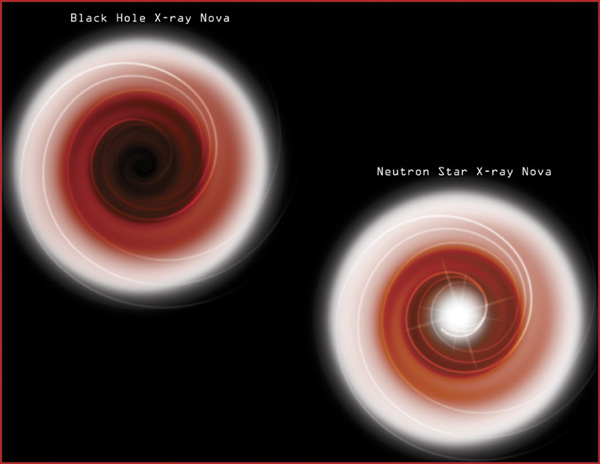
 Credit: CXC/M. Weiss
Credit: CXC/M. Weiss
Black Black Holes
"It is a bit odd to say we've discovered something by seeing almost nothing
at all -- less than the smile of the Cheshire cat, so to speak, but, in
essence, this is what we have done." said Dr. Michael Garcia of the
Harvard-Smithsonian Center for Astrophysics. Dr Garcia was referring to
startlingly new evidence of the existence of "event horizons" in the
Universe. An "event horizon" is popularly often thought of as the
"surface" around a black
hole; in reality these "horizons" represent local boundaries in
Einstein's spacetime. Objects inside the boundary cannot communicate with
objects outside the boundary. Thus things that pass the event horizon (or
"fall into a black hole", so to speak) are effectively "lost" to the rest
of the Universe. Garcia and his colleagues (Jeffrey McClintock, Ramesh
Narayan, and Stephen Murray of the Harvard-Smithsonian Center for
Astrophysics and Dr. Paul Callanan of University College, Cork, Ireland)
used data obtained by the Chandra
and ROSAT X-ray telescopes to probe
"X-ray novae" (violently variable stars which sometime erupt in a burst of
X radiation). These novae are powered by unstable flows of matter which
spiral onto the surface of a neutron star, or into a black hole. The
Chandra and ROSAT data showed that, when not experiencing a violent
outburst, the X-ray novae which contain black holes were only 1% as bright
as the X-ray novae which contain neutron
stars. The interpretation of the missing light is that it probably a
result of the black hole completely swallowing material (and the radiation
it produces) as the material passes the boundary of the event horizon.
Last Week *
HEA Dictionary * Archive
* Search HEAPOW
* Education
Each week the HEASARC
brings you new, exciting and beautiful images from X-ray and Gamma ray
astronomy. Check back each week and be sure to check out the HEAPOW archive!
Page Author: Dr. Michael F.
Corcoran
Last modified March 19, 2001


